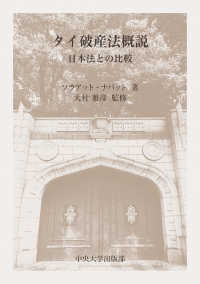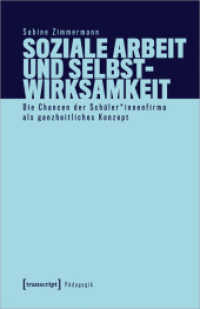- ホーム
- > 洋書
- > 英文書
- > Literary Criticism
Full Description
Don Quijote and Le Berger extravagant criticize fiction but come in the shape of novels. Far from breaking with their respective traditions, they engage with the chivalric and the pastoral in a creative manner. Genre and imitation are key notions for situating these novels in literary history and in the œuvres of Cervantes and Sorel. With emphasis on the continuity of each writer's approach, Le Berger extravagant is considered in the context of Sorel's aim to educate readers and avoid romance stereotypes, while the Quijote is read as an individual take on the chivalric novel, rejecting the Spanish tradition in favor of the ironic Italian romanzo cavalleresco. Like Cervantes' Galatea and Persiles, Don Quijote reflects a specific tradition which in turn serves to illuminate the famous book. This study offers interpretations of the two novels, but extends its scope toward the authors' other works and additional contemporary sources including Avellaneda's 1614 continuation of Don Quijote.
Contents
Preface
Part I: Charles Sorel's Berger extravagant
By way of introduction: An early testimony
A brief word on method
Sorel's poetics
Utilitas
Berger extravagant and Anti-Roman
The genre of the novel(s)
The structure of the Berger extravagant
The meaning of the Anti-Roman
Charles Sorel, novelist; or, the quest for vraisemblance
Conclusion: Novel or treatise?
Part II: Cervantes' Don Quijote
Principles of method
First solution: Don Quijote as criticism
Cervantes' stylistic tradition
Humor and genre
Cervantes and genre
Don Quijote as a chivalric romance
Part III: The Larger Picture
Backgrounds
Cervantes and Avellaneda
Sorel's Polyandre, a new histoire comique
Conclusion: Genre and 'Parody'
Appendix: A Problem of Terminology
Bibliography
Index








